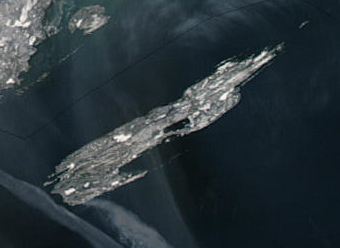By COLLEEN OTTE
Capital News Service
LANSING — The introduction of invasive species and the decline of native species are among the most pressing issues facing Isle Royale, according to the national park’s top administrator.
And rising temperatures make those problems even worse, Park Superintendent Phyllis Green said.

Satellite image of Isle Royale in northwest Lake Superior. Credit: NASA.
“Some things that factor into the islands pretty heavily are that winds over the Great Lakes are stronger – Lake Superior being about 12 percent higher than it was in 1985,” Green said in a talk at Michigan State University. “And the waters in the Great Lakes are hotter, increasing faster than the air temperatures.”
Lake Superior’s temperature rose 4.5 degrees from 1979 to 2006, double the air temperature increases. The added heat could help with the survival of aquatic invasive species, Green said.
“Lake Superior has long had that buffer of that arctic, cold water from aquatic invasives, but I have a real concern that (rising temperatures) will open it up to more,” she said.
One of the first species going extinct is the cisco in Isle Royale’s Sargent Lake. Water temperatures have increased to a level that the fish, which are genetically unique to the lake, cannot survive, Green said.
It’s a problem that undermines some of the park’s greatest attributes.
“A lot of people associate Isle Royale with wilderness landscapes and backpacking—we are three-quarters water,” she said. “We harbor the most intact native fisheries in the Great Lakes, with the least damage from aquatic invasive species.”
But strong winds and storm surges can move species onto the island that might not have arrived otherwise, Green said. Extreme conditions like drought could compound the problem.
“I think what people forget about in climate change is the concept that there’s going to be extremes,” she said.
For example, the latest El Niño weather pattern caused a lack of ice for wolves to travel between the island and mainland, Green said. This winter just two wolves were accounted for on the island, and they are inbred.
Wandering wolves aren’t the only ones at risk – humans exploring the island may soon experience climate change’s effects as well.
Springs that provide water to hikers along a 45-mile island trail are in danger of drying up, Green said.
In 2013, park managers pulled together experts on moose, moles, vegetation and other subjects to predict how they would be affected by warming conditions
One scenario featured frequent disastrous events – high winds, droughts and fires that would occur during very dry summers. Another explored seasonal temperature increases that were steadier, but very high. Lastly, they assessed a scenario in which the warmer temperatures caused drought, Green said.
The wolf population decreased or stayed even in all the scenarios, even under the least change, she said. Moose didn’t do well in most of the scenarios. The ideal temperature for moose is 28 degrees and Green said she’s watched one die from heat stroke.
Experts also see a shift in the composition of Isle Royale’s trees, she said, with an increase in the hardwood forests and a general loss of boreal forests.
There are also questions about the impact of greenhouse gas emissions caused by people, she said.
“We affect the landscape, but how much should we?” Green said. “That’s a very central question to this isolated island.”
For example, Green questions whether she should focus limited resources on seed banks for all the plant species the island could lose, or whether she should invest in a top predator like the wolf to control other species’ populations.
“We accept the fact that climate change is going to happen, so we have to look forward,” Green said. “And the crystal ball’s not clear. So in that process, where do you want to spend money? Are we going to slow change here at Isle Royale?
“The Park Service has a very difficult preserve and protect role because people have expectations of the park they’ve seen since childhood, and what it ought to look like, and what’s supposed to be there when they bring their grandkids back there.”
Colleen Otte writes for Great Lakes Echo.